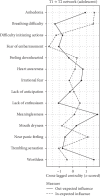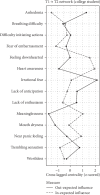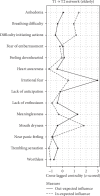Longitudinal Associations Between Anxiety and Depressive Symptoms in Adolescence, Early Adulthood, and Old Age: Cross-Lagged Panel Network Analyses
- PMID: 40226714
- PMCID: PMC11919059
- DOI: 10.1155/da/6205475
Longitudinal Associations Between Anxiety and Depressive Symptoms in Adolescence, Early Adulthood, and Old Age: Cross-Lagged Panel Network Analyses
Abstract
Background: Depression and anxiety are among the most prevalent psychiatric disorders worldwide, affecting individuals of all ages. The co-occurrence of these disorders often exacerbates their negative health impacts, underscoring the necessity of understanding their comorbid mechanisms. Methods: This study employed cross-lagged panel networks (CLPNs) to explore the longitudinal associations between depression and anxiety symptoms across three age groups and to compare the respective symptom networks. CLPNs were constructed through cross-temporal associations between different symptoms, reflecting both the pattern of interaction and the significance of specific symptoms in comorbidity. The sample consisted of 1258 adolescents (aged 13-19 years, M = 15.98), 1118 college students (aged 17-24 years, M = 19.94), and 548 older adults (aged 60-101 years, M = 85.19) from China. Depression and anxiety symptoms were assessed using the subscales of the Depression, Anxiety, and Stress Scale Short Version (DASS-21) at two time points over a 6-month period during 2020-2021. Results: The findings revealed that the prevalence of depression and anxiety in adolescents, college students, and older adults was 25.9%/46.6%, 53.7%/61.5%, and 7.2%/22.5%, respectively. The network structure varied across age groups: adolescents and college students exhibiting a tight interconnection between depression and anxiety symptoms, while older adults showed stronger small-world network characteristics. A key finding across all age groups was the central role of irrational fear. In addition, somatic anxiety symptoms frequently emerged as outcomes of other psychological symptoms. Conclusion: Depression and anxiety are more pronounced in college students compared to adolescents and older adults. Comparisons of the overall network structure provide insights into the lifelong trajectories of depression and anxiety symptom networks. The centrality of irrational fears and somatization symptoms is emphasized. These results offer guidance for more targeted clinical interventions.
Keywords: anxiety; cross-lagged panel networks; depression.
Copyright © 2024 Shoushi Wang et al.
Conflict of interest statement
The authors declare no conflicts of interest.
Figures




Similar articles
-
The Longitudinal Effect of Psychological Distress on Internet Addiction Symptoms Among Chinese College Students: Cross-Lagged Panel Network Analysis.J Med Internet Res. 2025 May 2;27:e70680. doi: 10.2196/70680. J Med Internet Res. 2025. PMID: 40315013 Free PMC article.
-
Dynamic networks of complex posttraumatic stress disorder and depression among college students with childhood trauma: insights from cross-sectional and cross-lagged panel network analysis.Eur J Psychotraumatol. 2024;15(1):2391656. doi: 10.1080/20008066.2024.2391656. Epub 2024 Sep 17. Eur J Psychotraumatol. 2024. PMID: 39286882 Free PMC article.
-
Longitudinal Relationships of Phubbing, Depression, and Anxiety in the Middle and High School Students: A Cross-Lagged Panel Network Analysis.J Adolesc. 2025 Jun;97(4):1074-1084. doi: 10.1002/jad.12481. Epub 2025 Feb 6. J Adolesc. 2025. PMID: 39916486
-
Longitudinal relations between non-suicidal self-injury and both depression and anxiety among senior high school adolescents: a cross-lagged panel network analysis.PeerJ. 2024 Oct 7;12:e18134. doi: 10.7717/peerj.18134. eCollection 2024. PeerJ. 2024. PMID: 39391828 Free PMC article.
-
The co-occurrence between symptoms of internet gaming disorder, depression, and anxiety in middle and late adolescence: A cross-lagged panel network analysis.Addict Behav. 2025 Feb;161:108215. doi: 10.1016/j.addbeh.2024.108215. Epub 2024 Nov 16. Addict Behav. 2025. PMID: 39566370
Cited by
-
Taking a Closer Look at Teacher Support and Children's Mental Health: The Mediating Role of Self-Concept and the Moderating Role of Area.Behav Sci (Basel). 2025 Jul 21;15(7):987. doi: 10.3390/bs15070987. Behav Sci (Basel). 2025. PMID: 40723771 Free PMC article.
-
Longitudinal Cross-Lagged Relationships of Complex Post-Traumatic Stress Disorder, Depression, and Anxiety Among Adolescents and Emerging Adults With Childhood Bullying Victimization Experiences.Depress Anxiety. 2025 Jun 13;2025:9166230. doi: 10.1155/da/9166230. eCollection 2025. Depress Anxiety. 2025. PMID: 40546685 Free PMC article.
References
-
- World Health Organization. Geneva:: World Health Organization; 2022. World Mental Health Report: Transforming Mental Health for All. Licence: CC BY-NC-SA 3.0 IGO.
-
- Abdoli N., Salari N., Darvishi N., et al. The Global Prevalence of Major Depressive Disorder (MDD) Among the Elderly: A Systematic Review and Meta-Analysis. Neuroscience & Biobehavioral Reviews . 2022;132:1067–1073. - PubMed
Publication types
MeSH terms
LinkOut - more resources
Full Text Sources
Medical

